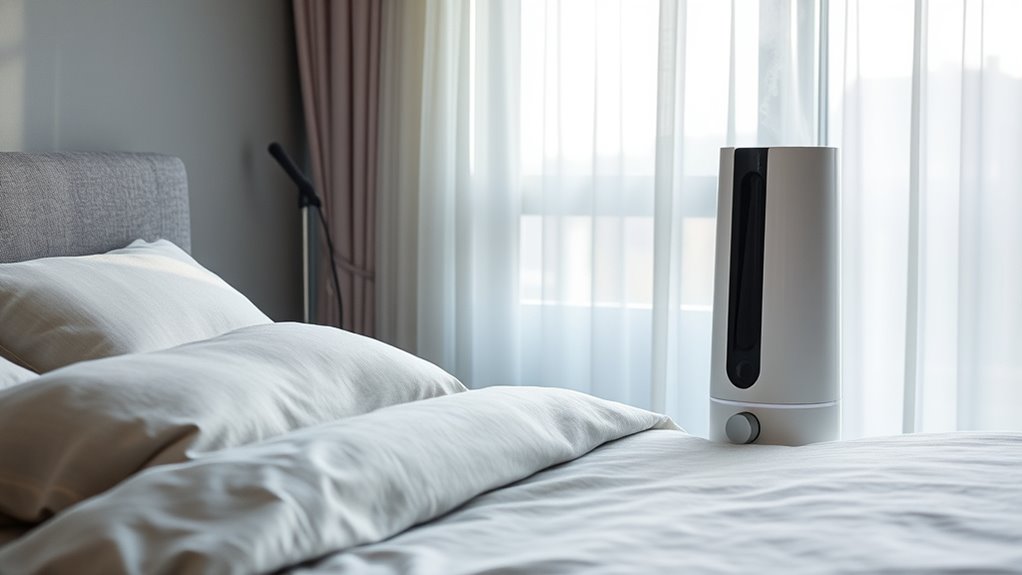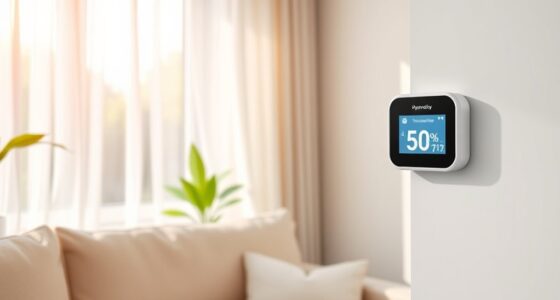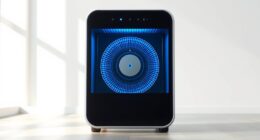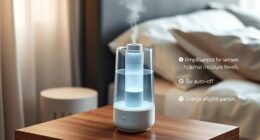If your bedroom is too dry, it can lead to discomfort, dry skin, nasal congestion, and disrupted sleep. Low humidity affects your breathing, makes your skin itchy, and increases static electricity. The ideal level is between 40% and 60%, which supports comfortable breathing and skin hydration. Use a hygrometer or humidifier to monitor and adjust your room’s moisture. Keep going to find out how to create a cozy, balanced environment that helps you sleep better.
Key Takeaways
- Humidity levels below 40% can cause dry skin, nasal congestion, and throat irritation, disrupting sleep quality.
- Signs of a too dry bedroom include dry skin, static electricity, creaky furniture, and difficulty breathing comfortably.
- Maintaining indoor humidity between 40-60% helps keep airways moist and supports better sleep.
- Using hygrometers or smart monitors can help track and adjust humidity to optimal levels.
- Incorporating humidifiers and indoor plants naturally increases moisture, improving sleep comfort and respiratory health.
Understanding the Role of Humidity in Sleep
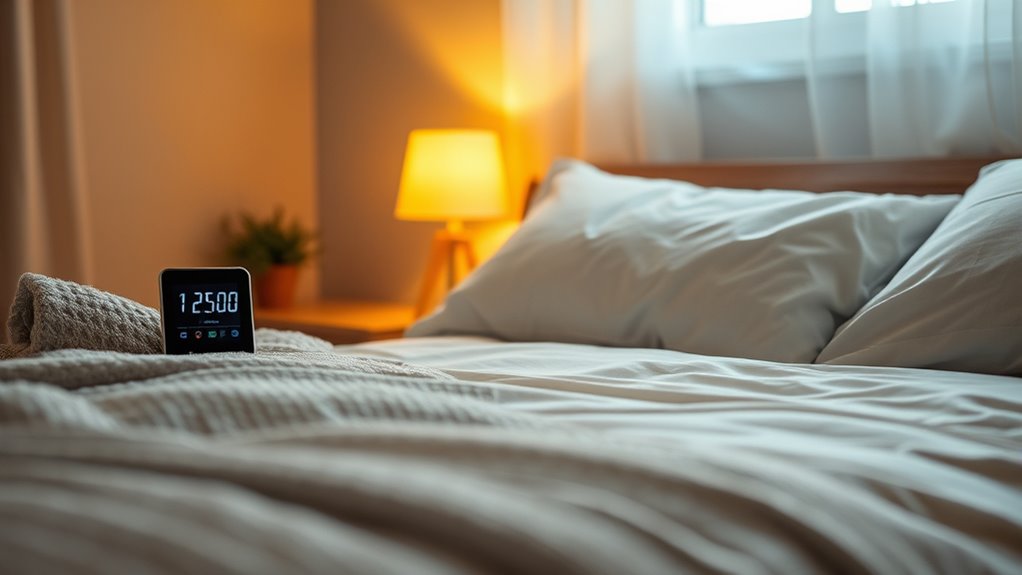
Humidity levels considerably influence your sleep quality because they affect how comfortably your body can regulate temperature and moisture. When humidity is just right, your environment maintains optimum moisture, preventing your skin and airways from drying out. Proper humidity regulation helps you breathe easier and keeps your body temperature stable throughout the night. Too much moisture can make the air feel heavy, leading to discomfort and restless sleep, while too little can cause dryness, irritation, and difficulty falling asleep. Achieving the right balance supports your body’s natural processes, ensuring you stay comfortable and relaxed. Additionally, automation technologies can assist in maintaining consistent humidity levels in your bedroom. Understanding the role of humidity in sleep helps you create an ideal bedroom environment that promotes restorative rest and overall well-being.
Signs Your Bedroom Might Be Too Dry
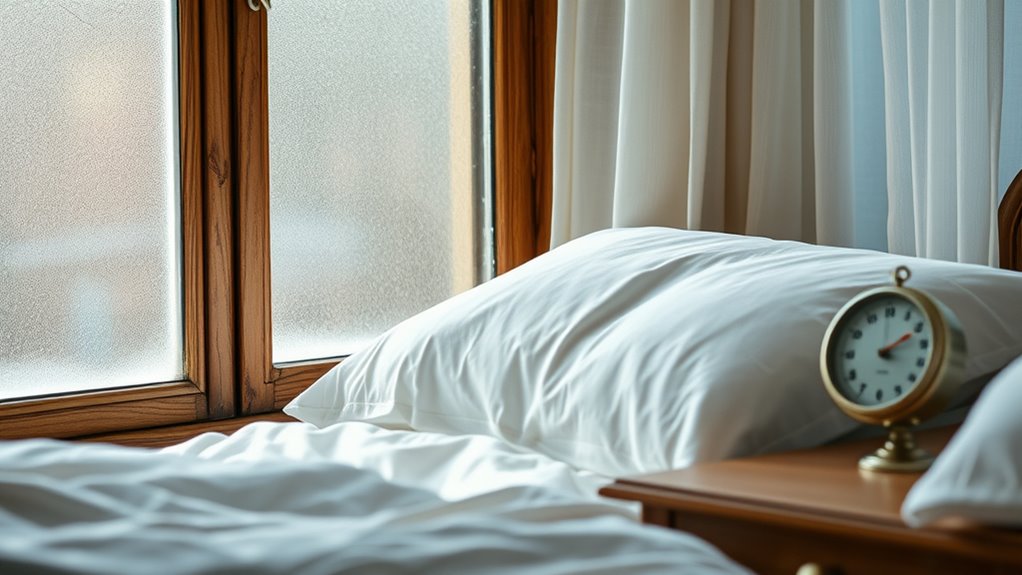
If your bedroom feels consistently dry and uncomfortable, it might be a sign that the air lacks sufficient moisture. You could notice dry skin that feels tight or flaky, especially after waking up. You might also experience nasal congestion or a sore throat, making it harder to breathe freely during the night. These signs indicate your environment isn’t maintaining ideal humidity levels, which can disrupt your sleep. You may also notice static electricity or wooden furniture creaking more than usual. If these symptoms sound familiar, it’s worth checking your room’s humidity. Low moisture content can cause discomfort and impact your sleep quality, so addressing these signs early can help create a more comfortable, restful sleeping environment.
How Low Humidity Affects Your Body During Sleep
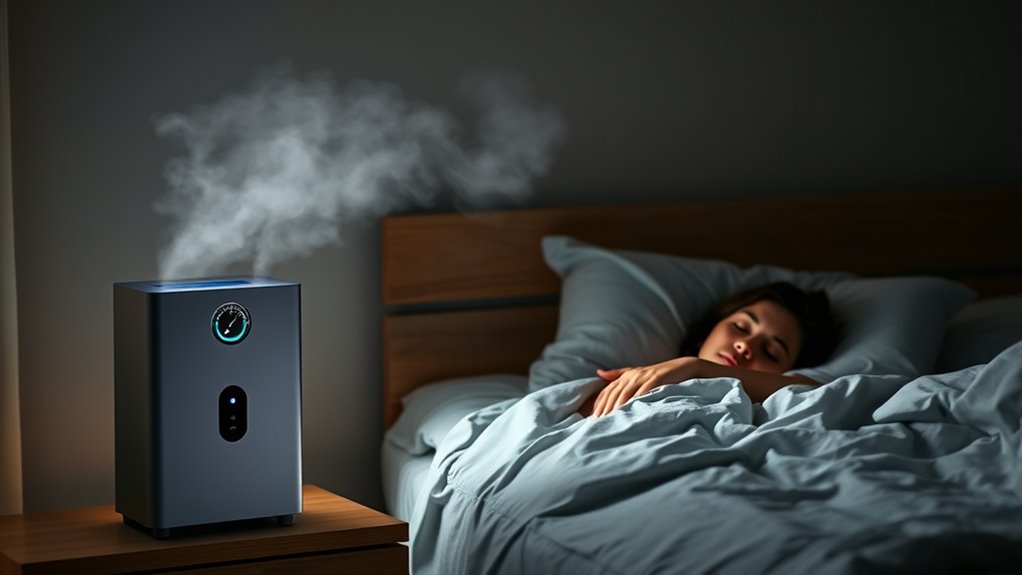
When the air in your bedroom is too dry, your body can experience several negative effects that disrupt your sleep. Low humidity causes your skin to become dry, flaky, and itchy, which can lead to discomfort and wakefulness throughout the night. It also impacts your breathing by drying out nasal passages and throat tissues, making it harder to breathe comfortably. This dryness can increase your risk of irritation, congestion, and even minor nosebleeds. As your body struggles to stay lubricated and maintain clear airways, your sleep quality declines. You might find yourself waking up frequently or feeling less rested. Keeping humidity levels balanced helps protect your skin and supports smoother, easier breathing during the night.
Ideal Humidity Levels for Restful Sleep

Maintaining the right humidity level in your bedroom is essential for achieving restful sleep. Ideally, keep indoor humidity between 40% and 60%. This range supports better breath quality by preventing your airways from drying out, reducing irritation and congestion. It also helps maintain skin hydration, so your skin doesn’t become dry or flaky overnight. When humidity is too low, you might notice discomfort, snoring, or waking up with a sore throat. Conversely, excessive moisture can promote mold growth and make the environment feel damp. By maintaining this ideal range, you create a sleep-friendly environment that promotes easier breathing, healthier skin, and overall comfort. Adjusting your room’s humidity to these levels can notably improve your sleep quality and wake up feeling refreshed. Proper humidification ensures consistent comfort and health benefits throughout the night.
Tools to Measure and Monitor Bedroom Humidity

To keep your bedroom humidity in check, you’ll want reliable tools like hygrometers and smart monitors. Hygrometers come in several types, each offering different features and accuracy levels. Smart humidity monitors can connect to your devices, providing real-time updates and easy control. Incorporating IoT devices can further enhance monitoring capabilities, allowing for automated adjustments to maintain optimal humidity levels.
Hygrometers and Their Types
Hygrometers are essential tools for accurately measuring and monitoring the humidity levels in your bedroom. They come in various types, including psychrometer types and digital hygrometers. Psychrometers use a wet-bulb and dry-bulb thermometer to determine humidity, offering precise readings for those who want detailed data. Digital hygrometers provide instant, easy-to-read measurements at a glance, making it simple to keep your bedroom at the perfect humidity level. Choosing the right hygrometer can help you identify when your environment is too dry or too humid, ensuring better sleep and comfort. Additionally, maintaining optimal humidity levels can contribute to overall lifestyle well-being, promoting healthier sleep habits.
Smart Humidity Monitors
Smart humidity monitors have revolutionized how you track and manage bedroom humidity by providing real-time data with minimal effort. These devices give you accurate readings of your room’s moisture levels, making it easy to maintain ideal conditions for sleep. With smart humidity monitors, you can set alerts to notify you if humidity falls outside your preferred range, enhancing your bedroom climate control. They often connect to your smartphone via apps, allowing you to monitor humidity remotely and adjust your humidifier or dehumidifier accordingly. This precision helps prevent dry air that disrupts sleep or excess moisture that promotes mold. Overall, smart humidity monitors simplify maintaining a healthy, comfortable sleeping environment, giving you peace of mind and better sleep quality.
Ways to Increase Humidity in Your Bedroom
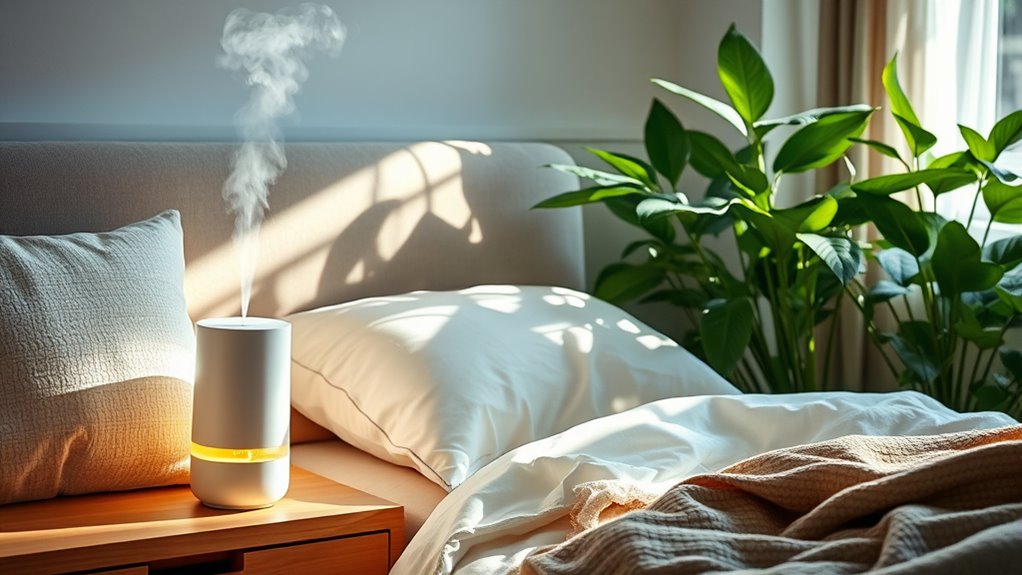
To boost humidity in your bedroom, consider using a humidifier to add moisture directly into the air. You can also place indoor plants around your space, which naturally release humidity. Both methods are simple and effective ways to improve your sleep environment. Additionally, choosing plants with high transpiration rates can maximize moisture release.
Use a Humidifier
Using a humidifier is one of the most effective ways to boost the moisture level in your bedroom. It helps prevent dry skin, sore throats, and disrupted sleep caused by low humidity. To guarantee it works properly, prioritize humidifier maintenance to avoid mold and bacteria buildup. When choosing the right humidifier, consider size, noise level, and ease of cleaning. Proper maintenance keeps your device running smoothly and your air clean. Incorporating a small wood stove can also help maintain consistent humidity levels by providing gentle warmth and moisture to your space. You’ll feel the difference as your skin and respiratory comfort improve, making bedtime more relaxing. A well-maintained humidifier transforms your sleep environment, creating a cozy, moisture-rich space that promotes restful nights.
- Feel the comfort of breathing easier
- Wake up refreshed and hydrated
- Sleep soundly in a healthier environment
Add Indoor Plants
Adding indoor plants is an easy and natural way to boost humidity levels in your bedroom. Indoor plant benefits include increasing moisture in the air, which can improve sleep quality and reduce dry skin. To maximize these benefits, place plants in areas with indirect sunlight and away from drafts. Grouping a few plants together enhances humidity effects through collective transpiration. Opt for varieties like pothos, snake plants, or peace lilies, which thrive indoors and help add moisture. Remember not to overwater, as excess water can lead to mold. Regularly dust your plants to keep them healthy and ensure they continue to support humidity. Proper plant placement tips will help you create a more humid, comfortable sleeping environment naturally. Additionally, choosing air-purifying plants can improve overall indoor air quality, further contributing to better sleep.
Additional Tips for Creating a Comfortable Sleep Environment

Creating a comfortable sleep environment involves more than just choosing the right mattress and pillows; managing humidity levels plays a crucial role. To enhance your sleep, focus on small adjustments that make a big difference. Practice breath awareness before bed to calm your mind and reduce stress, helping you settle into a restful sleep. Pay attention to your sleep position—finding the most comfortable one can reduce strain and promote better breathing. Keep your room at an ideal humidity level to prevent dryness that disrupts sleep or causes discomfort. You can also try these tips:
- Use a humidifier or diffuser to maintain suitable moisture levels
- Keep your bedroom cool and dark for better sleep quality
- Incorporate calming scents like lavender to relax your mind and body
- Regularly monitor your room’s air quality to ensure a healthy sleeping environment
When to Seek Professional Help for Sleep Issues Related to Humidity
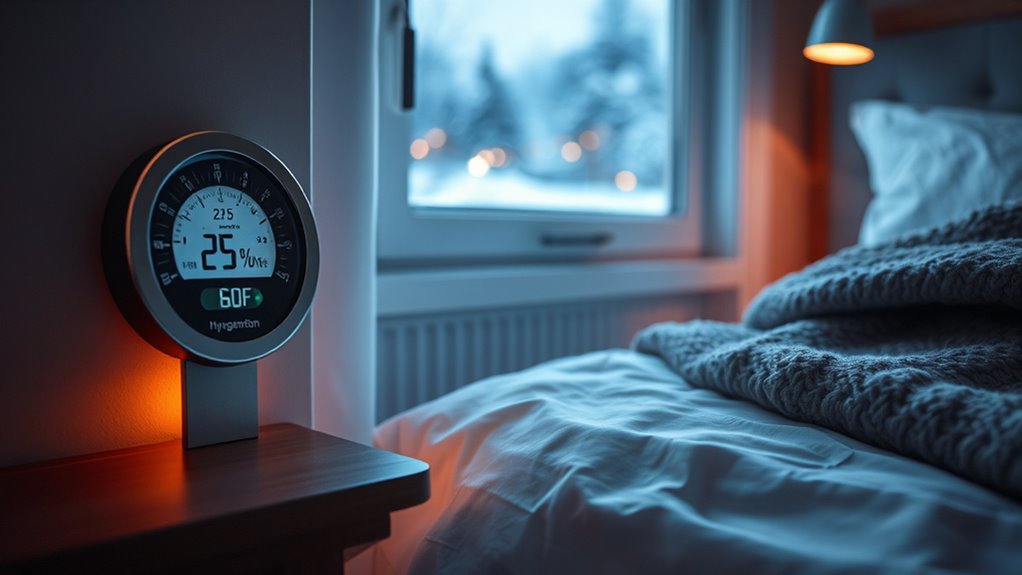
If you’ve adjusted your room’s humidity levels and still experience persistent sleep problems, it’s time to seek professional help. Poor sleep that doesn’t improve despite proper humidifier maintenance might signal an underlying sleep disorder. Watch for sleep disorder symptoms like loud snoring, gasping, frequent awakenings, or daytime fatigue. These issues may be worsened by improper humidity, but they often require expert diagnosis and treatment. Don’t ignore ongoing sleep issues; consulting a healthcare professional or sleep specialist can help identify the root cause. They may recommend specific tests or therapies tailored to your needs. Addressing both humidity and sleep disorder symptoms ensures you get the restful sleep your body needs and prevents potential health complications. Incorporating innovative cloud solutions can also support better sleep hygiene through smart home technologies that monitor and optimize bedroom conditions.
Frequently Asked Questions
Can Humidity Levels Affect Sleep Apnea Severity?
Higher humidity levels can influence sleep apnea severity by improving air quality and sleep comfort. When the air is too dry, your airways may become irritated or inflamed, making breathing more difficult during sleep. Maintaining ideal humidity helps keep your airways moist and reduces breathing disruptions. You might notice fewer apnea episodes and better sleep overall. So, managing humidity can be a simple way to support healthier breathing and improve your sleep quality.
How Does Humidity Impact Allergy Symptoms During Sleep?
You might notice allergy symptoms worsen during sleep, especially if your bedroom’s humidity is too low. Dry air can cause nasal congestion and irritate your respiratory passages, making allergy relief more difficult. Maintaining proper humidity levels helps keep nasal passages moist, reducing congestion and allergy symptoms. Using a humidifier can make a noticeable difference, allowing you to breathe easier, sleep better, and wake up feeling more refreshed.
Are There Specific Health Conditions Worsened by Dry Air?
You might notice certain health conditions worsen with dry air, especially if you have airway inflammation or skin dehydration. Dry air can irritate your respiratory passages, making breathing more difficult and increasing coughing or asthma symptoms. It also strips moisture from your skin, leading to dryness, irritation, and discomfort. If you already have respiratory or skin issues, maintaining proper humidity levels can help reduce these symptoms and promote better overall health.
Can Humidifiers Cause Mold or Other Indoor Air Problems?
Humidifiers can cause mold growth if you don’t clean them regularly, which affects your air quality. Excess moisture creates a perfect environment for mold and bacteria to thrive, potentially leading to indoor air problems. To prevent this, you should clean your humidifier often and keep humidity levels balanced. Proper maintenance guarantees you enjoy the benefits without risking mold growth or compromising your indoor air quality.
What Are the Best Times to Adjust Bedroom Humidity?
Imagine your bedroom as a garden needing just the right moisture to flourish. You should adjust humidity seasonally, increasing it during dry winter months and reducing it in humid summer. Keep an eye on seasonal humidity levels, and use proper bedroom ventilation to maintain balance. Regularly tweaking your humidifier settings guarantees your sleep environment stays comfortable, preventing dryness or excess moisture that can disrupt restful sleep.
Conclusion
So, next time you wake up feeling like a desert traveler instead of well-rested, remember—maybe it’s not your dreams, but your dry bedroom that’s the real culprit. Don’t let your sleep turn into a Sahara adventure. Keep an eye on humidity levels, boost them when needed, and turn your room into a cozy oasis. After all, who knew that your best sleep might just depend on not turning your bedroom into a personal drought?
